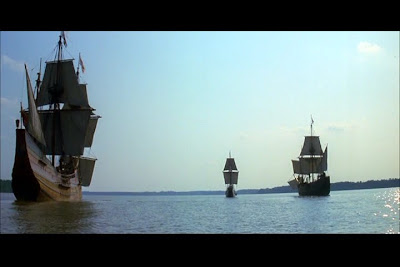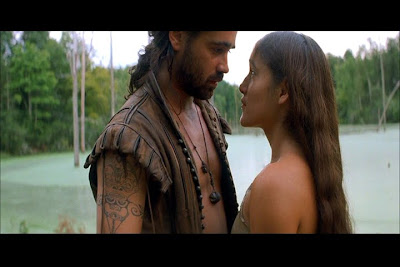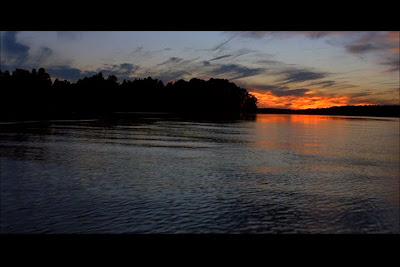
The countdown began exactly six months ago today. All the way back on May 28, with the posting of a review of Josef von Sternberg’s
The Blue Angel, the countdown began and now we’ve made it all the way through 2008. At the start, I had only a general idea how the entire thing would work out – if I would have the stamina to pump out enough quality writing to keep things interesting and, even more importantly, if I had enough movie knowledge to make justifiable selections. There were two small breaks in the process, but for the majority of the countdown, the every other day schedule was followed and worked well. With the exception of a few reviews that were posted prior to the start of the project, I wrote all of the reviews as we went, mainly because I wanted the luxury of being able to include newly-seen films into the countdown if I watched them in time. This meant sometimes I was able to work ahead and have reviews for the next few years ready and waiting, while others I had to scramble to get them done to remain on schedule. But through it all, I had a blast.
The major reason it was so much fun for me was everybody that followed and joined in on the selections. So to everyone, I owe huge thanks. The number of followers steadily grew as we progressed through the years, but a number of people have remained in involved since day one. Sam Juliano is one of the nicest guys in the world and has ceaselessly encouraged me in this project and also brought it to the attention of readers at his excellent Wonders in the Dark blog. John Greco, who does excellent work of his own at Twenty Four Frames, has been here since day one of the blog and has been a part of the countdown the entire way through. Judy from Movie Classics has been along for the entire ride. Samuel Wilson, who keeps a pace even more impressive than my own at his Mondo 70, is also a charter member of the countdown. I thank all of you for sticking it out for the entire ride. Other great contributors have been a significant factor as well. MovieMan joined in on selections late, but made a herculean effort to catching up with us in 1990 in a matter of a week or two. He’s been around ever since, adding his own selections and opinions. Shubhajit is constantly involved. Just another film blog joined us late in the countdown, but his contributions have been excellent. And there have been many others intermittently jumping into the fray – David Schleicher, Troy Olson, C.K. Dexter Haven, Ed Howard, Angelo, Stephen, CagneyFan, Sebina, and if I’m leaving anybody out I apologize. Truly, the reason it has been so enjoyable for me is the comments and interaction and seeing everyone else’s selections.
I thought I might just do a round-up post, with some statistics on the countdown and also an “On Second Thought” section in which I point out years where I would possible change my selection now if I had a second opportunity. I figured it would be a nice way to recap all the fun we (at least I hope “we” and not just “I”) have had for the last six months.
STATISTICSI acknowledged from the start that due to my viewing history, the selections were going to have an extremely English-speaking or Hollywood slant. That certainly proved to be the case, but there were still a number of films from around the world that I included in the countdown. Here are some breakdowns for the countries.
- France: 7 films
- Germany: 6 films
- Italy: 4 films (counting Once Upon a Time in the West, even though it's in English)
- Brazil: 1 film
- Denmark: 1 film
- Poland: 1 film
- Soviet Union: 1 film
- Spain: 1 film
- Sweden: 1 film
This shows that there is much world cinema I need to get to, but I thankfully avoided what my worst fear was going in – a situation where virtually everything was from Hollywood. So some good and bad come from these statistics. The other plus concerning world cinema is the fact that a lot of people listed films that I have never seen, or some cases had no idea about, that I can now look for and watch. My list of things to watch, just from recommendations in this countdown, is enormous.
DIRECTORSI was also very interested to see which directors would make multiple appearances and who would ultimately have the highest number of movies selected. Here are some stats on multiple appearances:
- Alfred Hitchcock: 3 films (1940-
Rebecca; 1954-
Rear Window; 1960-
Psycho)
- Francis Ford Coppola: 3 films (1972-
The Godfather; 1974-
The Godfather Part II; 1979-
Apocalypse Now)
- Martin Scorsese: 3 films (1980-Raging Bull; 1983-The King of Comedy; 1990-Goodfellas)
- Fritz Lang: 2 films (1931-
M; 1945-
Scarlet Street)
- Michael Curtiz: 2 films (1938-
Angles With Dirty Faces; 1942:
Casablanca)
- Jacques Tourneur: 2 films (1943-
I Walked with a Zombie; 1947-
Out of the Past)
- Robert Siodmak: 2 films (1946-
The Killers; 1949-
Criss Cross)
- Howard Hawks: 2 films (1948-
Red River; 1959-
Rio Bravo)
- Jean-Pierre Melville: 2 films (1967-
Le Samourai; 1969-
Army of Shadows)
- Sergio Leone: 2 films (1968-
Once Upon a Time in the West; 1984-
Once Upon a Time in America)
- Woody Allen: 2 films (1977-
Annie Hall; 1986-
Hannah and Her Sisters)
- Terrence Malick: 2 films (1978-
Days of Heaven; 2005-
The New World)
I'm glad to see some directors make the list with more than one film -- guys like Curtiz and Tourneur are often given credit only for their single biggest films, so it was nice to show that they were far more important than just
Casablanca and
Out of the Past. And while it might be entirely a reflection of my personal tastes, I like seeing Robert Siodmak pop up on the countdown multiple times.
ON SECOND THOUGHT…Whether it was because I saw a movie after I had already made a selection or because I simply changed my mind later in the countdown, there are a few choices that I would probably do differently now. This isn’t meant to invalidate any of my original selections; I stand by all of them. It just highlights how tight some of these selections can be, and how depending on the day, the answers can vary. I think it’s an interesting thing to consider how tastes or viewpoints might have changed over the course of the countdown.
1939 – My original selection in this year was
The Rules of the Game, the all-time classic from Jean Renoir. I found the selection funny, though, because with my usual Hollywood slant, I managed to not pick a single film from Tinseltown in what is considered the greatest year in Hollywood history. My opinion of
The Rules of the Game has not gone down at all, but the way I feel toward the immortal
Gone With the Wind has only increased. I now find the movie simply irresistible. Never has the term “they don’t make ‘em like that anymore” been so applicable. The epic story, the sweeping scale of everything, the instantly-recognizable score – it’s the studio system at its finest. For anyone who loves the film, I certainly recommend checking out the 70th Anniversary Edition DVDs that were released about two weeks ago. I bought the Ultimate Collector’s Edition, which is a six-disc monstrosity that has enough extras to keep you busy for weeks.
1941 – Yes, I would replace the film that is commonly cited as the greatest ever made, which would mean not a single work from Orson Welles in the entire project. Shortly after the countdown began, I went on a Preston Sturges binge and he quickly has become a personal favorite. 1941 was the biggest year of Sturges’ career, as he released two of his most acclaimed films in
The Lady Eve and
Sullivan’s Travels. Both are must-sees, but I consider
The Lady Eve to be the finest film that Sturges made in his short but productive career. There was no better comedy writer in Hollywood in this era, and he makes the zany screwball farce seem so genuine, helped greatly by performances from Barbara Stanwyck, Henry Fonda and the stock players that are found in all of his films. There is no question that this is one that I would definitely have to switch.
1960 – I don’t know that I would definitely change my pick for 1960, as Alfred Hitchcock’s
Psycho is on a shortlist of my all-time favorite films. But I do have to admit that if I was making the selection right now, it’s highly possible that I would instead go with Billy Wilder’s
The Apartment. Not only is it among the funniest comedies ever made, containing a usual superb Jack Lemmon performance, but the black and white photography from Joseph LaShelle is incredible. The black shades are pitch-black, creating quite the contrasts. So, this might not necessarily be a complete change, but it would be much closer than my original selection process.
2009 – I didn’t want to make a full-blown selection for this year since it has not completely run its course yet. Plus, the main issue of not having seen enough films. But if I would make a pick, it would have to be Pixar’s fabulous
Up (Pete Docter and Bob Peterson). I loved it so much that I’m now planning on going back and catching up on all of the Pixar films, very few of which I have seen. Of those that I’ve actually watched, I would rank
Up as my favorite. The opening twenty minutes are silent film of the highest order, on par with anything I’ve ever seen. It’s akin to a 20th century version of Buster Keaton or Chaplin. Having never been a big fan of animation, this one was a revelation for me.
If anybody else would like to throw in what would be their top film for 2009, by all means put the in the comments section here. As I said, I can use any and all selections for this year, having seen very little.
A FINAL LISTFor ranking junkies like me and Sam, we’ve never seen a list of movies we didn’t want to try and put in some kind of order. I’m sure that there are others reading this that have similar list-making addictions. So one afternoon I had the idea of attempting to rank my choices for each year. Admittedly, a lot of films are interchangeable in terms of where I would rank them – it just depends on
when I’m putting them in order. The only criterion for the list is personal preference. The Top 20 could probably be inverted and I wouldn’t argue too much. A frivolous exercise, I’m sure, but I live for making such lists and rankings!
1. Rear Window (1954, Hitchcock)
2. Goodfellas (1990, Scorsese)
3. Sweet Smell of Success (1957, Mackendrick)
4. The Godfather (1972, Coppola)
5. JFK (1991, Stone)
6. Out of the Past (1947, Tourneur)
7. The New World (2005, Malick)
8. Casablanca (1942, Curtiz)
9. Rio Bravo (1959, Hawks)
10. The Conformist (1970, Bertolucci)
11. Kiss Me Deadly (1955, Aldrich)
12. Apocalypse Now (1979, Coppola)
13. Unforgiven (1992, Eastwood)
14. The Godfather Part II (1974, Coppola)
15. The Assassination of Jesse James by the Coward Robert Ford (2007, Dominik)
16. Army of Shadows (1969, Melville)
17. Angels With Dirty Faces (1938, Curtiz)
18. Trouble in Paradise (1932, Lubitsch)
19. Psycho (1960, Hitchcock)
20. Mafioso (1962, Lattuada)
21. Raging Bull (1980, Scorsese)
22. The Big Lebowski (1998, Coen Brothers)
23. All About Eve (1950, Mankiewicz)
24. Le Samourai (Melville, 1967)
25. Mulholland Dr. (2001, Lynch)
26. Pat Garrett and Billy the Kid (1973, Peckinpah)
27. Criss Cross (1949, Siodmak)
28. Back to the Future (1985, Zemeckis)
29. Modern Times (1936, Chaplin)
30. Once Upon a Time in America (1984, Leone)
31. The Killers 1946, Siodmak)
32. Days of Heaven (1978, Malick)
33. The Searchers (1956, Ford)
34. L.A. Confidential (1997, Hanson)
35. Rebecca (1940, Hitchcock)
36. Hamlet (1964, Kozintsev)
37. Red River (1948, Hawks)
38. Pulp Fiction (1994, Tarantino)
39. M (1932, Lang)
40. Henry V (1989, Branagh)
41. I Walked with a Zombie (1943, Tourneur)
42. The Thin Man (1934, Van Dyke)
43. Lost in Translation (2003, Coppola)
44. Double Indemnity (1944, Wilder)
45. Lone Star (1996, Sayles)
46. Once Upon a Time in the West (1968, Leone)
47. A Place in the Sun (1951, Stevens)
48. Fitzcarraldo (1982, Herzog)
49. Madame de... (1953, Ophuls)
50. The Innocents (1951, Clayton)
51. Citizen Kane (1941, Welles)
52. McCabe & Mrs. Miller (1971, Altman)
53. Scarlet Street (1945, Lang)
54. Persona (1966, Bergman)
55. El Verdugo (1963, Berlanga)
56. The Remains of the Day (1993, Ivory)
57. Downfall (2004, Hirschbiegel)
58. A Star is Born (1937, Wellman)
59. The Rules of the Game (1939, Renoir)
60. Hannah and Her Sisters (1986, Allen)
61. Mr. Klein (1976, Losey)
62. Repulsion (1965, Polanski)
63. Au Revoir les Enfants (1987, Malle)
64. Raiders of the Lost Ark (1981, spielberg)
65. Flame & Citron (2008, Madsen)
66. Casque d'or (1952, Becker)
67. The Lives of Others (2006, von Donnersmarck)
68. City of God (2002, Meirelles)
69. Cinema Paradiso (1988, Tornatore)
70. Crouching Tiger, Hidden Dragon (2000, Lee)
71. Heat (1995, Mann)
72. Ashes and Diamonds (1958, Wajda)
73. Eyes Wide Shut (1999, Kubrick)
74. Dog Day Afternoon (1975, Lumet)
75. Annie Hall (1977, Allen)
76. The King of Comedy (1983, Scorsese)
77. The Bitter Tea of General Yen (1933, Capra)
78. Les Miserables (1935, Boleslawski)
79. Der blaue Engel (1930, von Sternberg)
Once again, thanks to everyone who was a part of the entire process. It was great fun! Who knows what I’ll do next, so I’m open to any suggestions.
 I know it’s been quiet around these parts lately. I’ve been recharging the creative and writing juices after completed the annual countdown and watching noirs like a madman in preparation for the next project. I’m just throwing up something now to kind of finalize plans and map out how I’m envisioning things playing out.
I know it’s been quiet around these parts lately. I’ve been recharging the creative and writing juices after completed the annual countdown and watching noirs like a madman in preparation for the next project. I’m just throwing up something now to kind of finalize plans and map out how I’m envisioning things playing out.
























